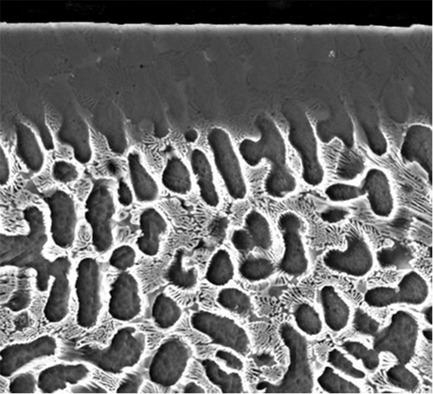当前位置:
X-MOL 学术
›
Adv. Eng. Mater.
›
论文详情
Our official English website, www.x-mol.net, welcomes your feedback! (Note: you will need to create a separate account there.)
Improvement of Wear and Corrosion Resistance of Austenitic Stainless Steel by Combined Treatment Using Electron Beam Cladding and Subsequent Gas Nitrocarburizing
Advanced Engineering Materials ( IF 3.6 ) Pub Date : 2019-09-16 , DOI: 10.1002/adem.201900365 Eugen Hegelmann 1 , Philipp Hengst 1 , Paul Hollmann 1 , Jens Thronicke 1 , Anja Buchwalder 1 , Christian Schimpf 2 , Ralph Hunger 3 , Rolf Zenker 1, 4
Advanced Engineering Materials ( IF 3.6 ) Pub Date : 2019-09-16 , DOI: 10.1002/adem.201900365 Eugen Hegelmann 1 , Philipp Hengst 1 , Paul Hollmann 1 , Jens Thronicke 1 , Anja Buchwalder 1 , Christian Schimpf 2 , Ralph Hunger 3 , Rolf Zenker 1, 4
Affiliation

|
The high passivation capacity of austenitic stainless steels results in excellent corrosion resistance in a wide variety of corrosion media. However, the tribological properties of these steels are insufficient due to their low hardness and high susceptibility to adhesive wear. To improve the wear behavior of austenitic steels while maintaining corrosion resistance, thermochemical processes such as nitriding or nitrocarburizing can be used. Such processes can be carried out as single procedures or in combination with coating techniques. Herein, the results of a new combination treatment consisting of the electron beam cladding (EBC) of a Co‐based alloy with subsequent gas nitrocarburizing (GNC) are presented. The effects of the beam deflection technique on the microstructure and phase formation of the cladded wear protection layer, the resulting hardness as well as the dilution ratio and the bonding of this layer to the base material are demonstrated. The subsequent gas nitrocaburizing leads to the formation of an ≈10 μm‐thick surface layer enriched with nitrogen and carbon. The significant improvement in wear resistance compared with the untreated base material is demonstrated by abrasive and adhesive‐abrasive wear tests. Corrosion resistance is investigated by recording current density—potential curves and long‐term tests in corrosive media.
中文翻译:

电子束熔覆与随后的气体氮碳共渗相结合的处理可改善奥氏体不锈钢的耐磨性和耐蚀性
奥氏体不锈钢的高钝化能力可在多种腐蚀介质中产生出色的耐腐蚀性。然而,由于这些钢的低硬度和对粘合剂磨损的高敏感性,它们的摩擦学性能不足。为了在保持耐腐蚀性的同时改善奥氏体钢的磨损性能,可以使用热化学工艺,例如氮化或氮碳共渗。这样的过程可以作为单个过程进行,也可以与涂覆技术结合进行。本文介绍了一种新的组合处理方法的结果,该方法由钴基合金的电子束熔覆(EBC)和随后的气体氮碳共渗(GNC)组成。束偏转技术对包覆耐磨保护层的微观结构和相形成的影响,证明了所得的硬度,稀释率以及该层与基材的粘合性。随后的气体渗氮渗碳导致形成约10μm厚的富含氮和碳的表面层。与未处理的基材相比,耐磨性有了显着改善,这已通过磨料和胶粘剂磨料磨损测试得以证明。通过记录电流密度(电位曲线)和在腐蚀性介质中的长期测试来研究耐腐蚀性。与未处理的基材相比,耐磨性有了显着提高,这已通过磨料和胶粘剂磨料磨损测试证明。通过记录电流密度(电位曲线)和在腐蚀性介质中的长期测试来研究耐腐蚀性。与未处理的基材相比,耐磨性有了显着改善,这已通过磨料和胶粘剂磨料磨损测试得以证明。通过记录电流密度(电位曲线)和在腐蚀性介质中的长期测试来研究耐腐蚀性。
更新日期:2019-09-16
中文翻译:

电子束熔覆与随后的气体氮碳共渗相结合的处理可改善奥氏体不锈钢的耐磨性和耐蚀性
奥氏体不锈钢的高钝化能力可在多种腐蚀介质中产生出色的耐腐蚀性。然而,由于这些钢的低硬度和对粘合剂磨损的高敏感性,它们的摩擦学性能不足。为了在保持耐腐蚀性的同时改善奥氏体钢的磨损性能,可以使用热化学工艺,例如氮化或氮碳共渗。这样的过程可以作为单个过程进行,也可以与涂覆技术结合进行。本文介绍了一种新的组合处理方法的结果,该方法由钴基合金的电子束熔覆(EBC)和随后的气体氮碳共渗(GNC)组成。束偏转技术对包覆耐磨保护层的微观结构和相形成的影响,证明了所得的硬度,稀释率以及该层与基材的粘合性。随后的气体渗氮渗碳导致形成约10μm厚的富含氮和碳的表面层。与未处理的基材相比,耐磨性有了显着改善,这已通过磨料和胶粘剂磨料磨损测试得以证明。通过记录电流密度(电位曲线)和在腐蚀性介质中的长期测试来研究耐腐蚀性。与未处理的基材相比,耐磨性有了显着提高,这已通过磨料和胶粘剂磨料磨损测试证明。通过记录电流密度(电位曲线)和在腐蚀性介质中的长期测试来研究耐腐蚀性。与未处理的基材相比,耐磨性有了显着改善,这已通过磨料和胶粘剂磨料磨损测试得以证明。通过记录电流密度(电位曲线)和在腐蚀性介质中的长期测试来研究耐腐蚀性。

























 京公网安备 11010802027423号
京公网安备 11010802027423号